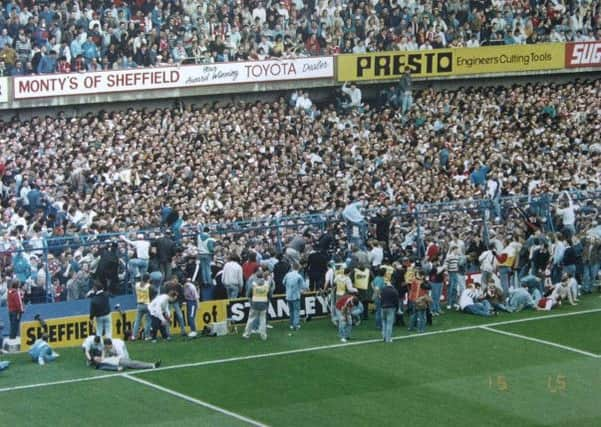Police took too long to take action at Hillsborough


Albert Page, the former chief ambulance officer for South Yorkshire Metropolitan Ambulance Service (SYMAS), also said “if possible” critically injured fans should have been treated on the pitch as the disaster became apparent.
But Mr Page said it was right that ambulances were not called onto the pitch in numbers because of the hundreds of fans spilling onto the playing area and vehicle access to the pitch being a “bottle-neck” only wide enough for one vehicle at a time to exit or enter.
Advertisement
Hide AdAdvertisement
Hide AdNinety-six Liverpool fans died following a crush on the Leppings Lane terrace of Sheffield’s Hillsborough ground as the FA Cup semi-final against Nottingham Forest kicked off on April 15, 1989.
Paul Eason, a senior ambulance officer, has told the inquest he was the “eyes and ears” of the service at the ground but his “big mistake” was initially presuming the incident on the terraces was a public order problem - not fans being crushed.
Today’s witness, Mr Page, said Mr Eason was “On his own” but there were, “dozens and dozens” of police officers, including senior officers who should have declared a major incident - putting a pre-ordained plan into action, calling in more resources and alerting local hospitals.
Mr Eason declared a major incident at 3.22pm, around 16 minutes after the match had been abandoned at 3.06pm.
Mr Page said this was: “Too long a delay.”
Advertisement
Hide AdAdvertisement
Hide AdHe said for the crushed fans asphyxiation was the “basic killer” and agreed people with such injuries should not be stretchered on their backs.
Christina Lambert QC, counsel for the inquests said: “What aught to have been in Mr Eason’s mind was the need to triage in a place close to the scene?”
Mr Page replied: “Yes, as I said before, dependent on the safety aspect.”
Miss Lambert suggested ambulance officers, with the help of police, could have set up a cordon to create a safe area on the pitch for casualties to be dealt with.
Advertisement
Hide AdAdvertisement
Hide AdMr Page replied: “Well could have been, if I refer to some of the questions you have been asking today, with regard to the police action, they just were not there when people needed.”
But the jury also heard the police control box at the match requested three times for a senior ambulance officer to make contact with them but there was no response.
The inquest heard only three ambulances made it onto the pitch, at 3.20pm, 3.35pm and another much later.
Miss Lambert suggested ambulances should have been sent on to the pitch to treat the injured.
Advertisement
Hide AdAdvertisement
Hide AdMr Page replied: “I disagree with that totally. Too many people climbing into ambulances and they were better off getting the triage done and moving the patients to hospital. It would have been a bottle-neck.”
Mr Page was not at the ground on the day of the disaster but went to the ambulance control HQ as the tragedy unfolded, arriving at 3.40pm.
He said he was initially told the disaster was a pitch invasion with 45 casualties.
Mr Page conceded there was difficulties in communication between himself and his senior officer at the stadium, deputy chief ambulance officer Alan Hopkins, and between the ambulance service and police.
Advertisement
Hide AdAdvertisement
Hide AdHe added: “There was not adequate communications between the two organisations.”
The witness was then shown a press release from SYMAS following the disaster, to “put the record straight” and claiming the ambulance service response was, “speedy and efficient”.
Mr Page said the press release was written by “barristers and solicitors” brought in by health service bosses after the disaster.
The hearing, in Warrington, was adjourned until tomorrow morning.